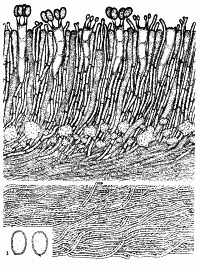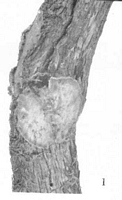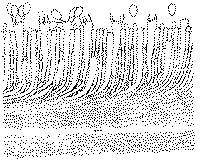|
 Aleurodiscus parmuliformis Aleurodiscus parmuliformis
SynonymsAleurodiscus pateriformis
BiostatusPresent in region - Indigenous. Endemic
Images (click to enlarge)
Caption: Pl. 24, fig. 3. Aleurodiscus parmuliformis, x 1. | 
Caption: Fig. 3. Aleurodiscus parmuliformis. Transverse section showing gloeocystidia and
pseudophyses, x 500. Spores, x 1000. | 
Caption: Pl. 24, fig. 1. Aleurodiscus pateriformis, x 1. | 
Caption: Fig. 2. Aleurodiscus pateriformis. Transverse section showing gloeocystidia and
pseudophyses, x 500. | |
Article: Cunningham, G.H. (1956). Thelephoraceae of New Zealand. Part XI. The genus Aleurodiscus. Transactions of the Royal Society of New Zealand 84(2): 237-268.
Description: Hymenophore annual, membranous, scutellate, consisting of numerous orbicular colonies 2-10 mm diameter, coalescing to form irregular linear areas to 6 cm long; margins in young
specimens upturned slightly, tan, hirsute, becoming plane, definite, white, arachnoid;
hymenial surface ivory-white, or cream, remaining so or becoming ochre, buff with reddish
tints, olive-brown or dingy-brown, finally deeply areolately creviced, segments separating
widely. Context white, to 0.5 mm thick, basal layer of mainly. parallel hyphae radiately
arranged, crystals embedded between the basal layer and subhymenium; generative hyphae 4-6 µ diameter, walls 1-1.5 µ thick, hyaline, freely branched, septate, without clamp
connexions. Hymenial layer to 100 µ deep, a dense palisade of basidia, paraphyses,
pseudophyses and gloeocysticlia. Basidia subclavate, 65-85 x 12-16 µ, 4-spored; sterigmata
slightly arcuate, subulate, to 12 µ long. Paraphyses subclavate, to 60 x 9 µ. Pseudophyses
cylindrical, slightly projecting, near the surface often bent or angled, apices acuminate or
rounded, sometimes forked. Gloeocystidia scanty or abundant in different collections, arising
in the base of the subhymenium, flexuous-cylindrical, 80-160 x 6-16 µ, apices rounded.
Spores broadly elliptical, oval or obovate, obliquely apiculate, 12-16 x 8-10 µ, walls smooth,
hyaline, 0.25 µ thick, amyloid.
Habitat: HABITAT. Adnate on bark of dead branches.
Distribution: DISTRIBUTION. New Zealand.
Notes: Separated from other species in this section by the scutellate pilei which are usually plane
with the surface of the substratum, and often attached throughout their breadth. The hymenial
surface may be white (as in the type), buff, or olivaceous, and the context is soft and readily
sectioned. Colonies soon merge to form irregular areas, which may extend to 6 cm. In most
collections the surface is scantily creviced; in two they are creviced so deeply that the white
basal layer is exposed, and segments separated by 0.5-1 mm. Gloeocystidia usually form a
palisade in the hymenial layer and are also scattered in the context. In one series they are
abundant and attain a diameter of 16 µ; in a second they are scanty and do not exceed a
diameter of 9 µ. Masses of crystals are usually embedded at the. base of the hymenial layer.
Article: Cunningham, G.H. (1956). Thelephoraceae of New Zealand. Part XI. The genus Aleurodiscus. Transactions of the Royal Society of New Zealand 84(2): 237-268.
Description: Hymenophore annual, coriaceous, pateriform, with upturned margins and broad bases, 5-28
mm diameter, sometimes connate laterally when extending to 4 cm; exterior bay-brown,
strongly radiate-striate, naked; margin chestnut-brown, crenate, inturned; hymenial surface
plane, ochre or pallid plum, at length creviced irregularly. Context isabelline, 0.5-0.75 mm
thick, basal layer of densely compacted radiately arranged hyphae, more densely woven
peripherally; generative hyphae 4-5 µ diameter, walls 1-1.5 µ thick, hyaline, branched,
septate, without clamp connexions. Hymenial layer 90-130 µ deep, a dense palisade of
basidia, paraphyses, pseudophyses and gloeocystidia. Basidia projecting slightly, subclavate,
64-110 x 10-12 µ, 4-spored; sterigmata slightly arcuate, subulate, to 12 µ long. Paraphyses
subclavate, to 40 x 8 µ. Pseudophyses flexuous-cylindrical, 5-6 µ, diameter, slightly
projecting, Gloeocystidia (1) penetrating the hymenial layer, arising from the base of the
subhymenium, flexuous-cylindrical, to 130 x 6-8 µ, (2) arising deeply in the context and
penetrating the base of the hymenial layer, flexuous-cylindrical or apically fusiform and
expanded, to 10 µ diameter, soon collapsing and leaving lacunae in the tissues. Spores
elliptical or obovate, apiculate, 11-16 x 8-10 µ, walls smooth, hyaline, 0.2 µ thick, amyloid.
Habitat: HABITAT. Scattered or crowded on bark of dead stems.
Distribution: DISTRIBUTION. New Zealand.
Notes: Fructifications are larger in diameter than in any other species examined, saucer-shaped, with
broad bases and upturned naked margins, and resemble somewhat in macrofeatures pilei of
certain species of Stereum. Spores are of the same size and shape as those of A.
parmuliformis. Gloeocystidia which penetrate the hymenial layer arise at the base of the
subhymenium and vary appreciably in diameter, most being flexuous-cylindrical with thin
walls; those which extend into the base of the hymenial layer arise deeply in the context,
often exceed 150 µ in length, and may be flexuous-cylindrical or simulate conducting vessels
with apices slightly inflated. The latter finally collapse, leaving lacunae in the base of the
subhymenium.
|